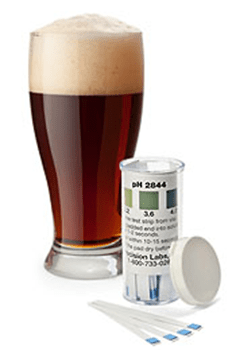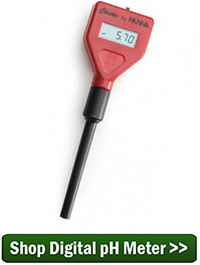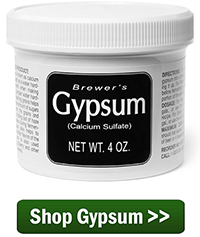 All-grain brewers need to mash their grains in order to extract fermentable sugars. This process, called conversion, takes place in water under certain conditions of volume, temperature, pH, and time. Today, we’ll talk about mash pH: ideal mash pH range, effects of being too high or too low, and how to use pH strips or digital meter to take pH readings and make corrective adjustments.
All-grain brewers need to mash their grains in order to extract fermentable sugars. This process, called conversion, takes place in water under certain conditions of volume, temperature, pH, and time. Today, we’ll talk about mash pH: ideal mash pH range, effects of being too high or too low, and how to use pH strips or digital meter to take pH readings and make corrective adjustments.
About Mash pH
pH is simply a measurement of how acidic or alkaline something is. On a scale of 0 to 14, a pH of 0.0 is highly acidic, 7.0 is neutral, and 14.0 is highly alkaline.
The ideal mash pH range of 5.0 to 5.5. A pH of 5.4 is considered “optimal” for most applications, and it’s a good target for brewers new to homebrew mashing.
Measuring Mash pH
Whether mashing for the first time or brewing your 100th batch, it’s important to measure your mash pH. No one wants to find out after the fact that their mash was ineffective and their target original gravity much too low.
The least expensive option for measuring mash pH is the pH test strip. For just a few dollars, brewers can take dozens of readings. All you do is dip the colored end of the strip into the mash for a second or two, remove it, and then read the color. The trade-off of the low price tag is that it’s kind of difficult to get an super, accurate reading from the test strips. Personally, the best I can do is approximate within about 0.2 how close I am to the target pH. This method might work fine for partial mash brewing and beginning all-grain brewers, but before long, they may want an upgrade.
The solution is a digital pH meter. Though it may be a little more expensive than a pack of test strips, the digital meter is significantly more accurate, and well worth the investment in my opinion.
Mash pH Adjustments
So now that you can measure your mash pH, how can you adjust it if it’s too high or too low?
To lower your mash pH (increase the acidity of the mash), add half a teaspoon of gypsum to a 5 or 6 gallon mash and stir well. To increase mash pH, add half a teaspoon of calcium carbonate to a 5 or 6 gallon mash and stir. Take pH readings and keep making adjustments until you are within the ideal mash pH range of 5.0 to 5.5, but do not add more than two teaspoons of either ingredient. If you choose to test the pH of your water prior to mashing in, keep in mind that adding grains to the water will cause the pH to drop.
Dealing with a mash pH, taking reading, making adjustments, etc., may sound challenging and technical, but once you get the hang of it, it will become second-nature, and you’ll be well on your way to exercising more control over your craft and brewing the beer that you ultimately want to drink.
—–
David Ackley is a beer writer, brewer, and self-described “craft beer crusader.” He is a graduate of the Oskar Blues Brew School in Brevard, NC.

Thanks for the article on Mash pH. The only question I have after reading it is your recommendation on WHEN to take the reading and HOW.
How many minutes into the mash is the best time to take the reading?
Should you cool the sample as well?
Frostman, whether you are using a digital pH meter or pH strips, you want to take the reading at the beginning of the mash. You will want to make any adjustments before you start the process.
Hi,
What about the temperature part of the question? I have been reading a lot and am confused if the ideal pH range is at room temp or mash temp. I’ve read that temp effects pH readings.
thanks